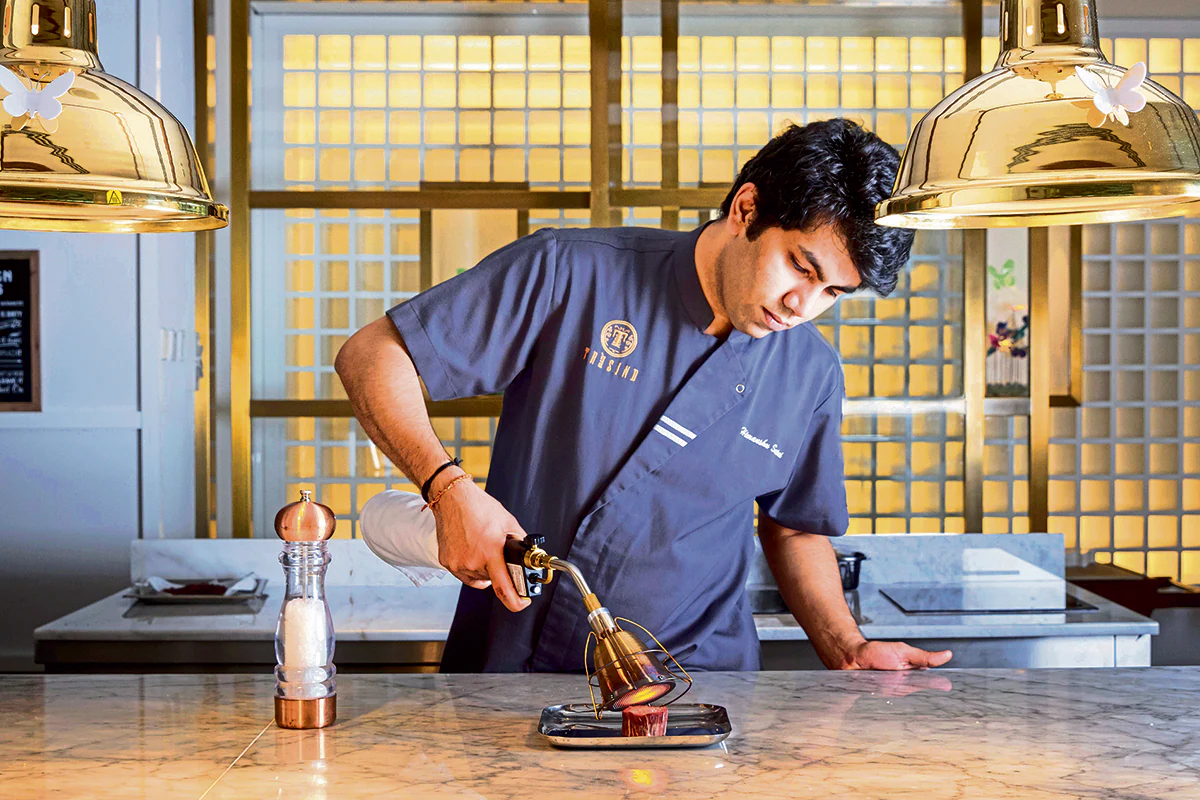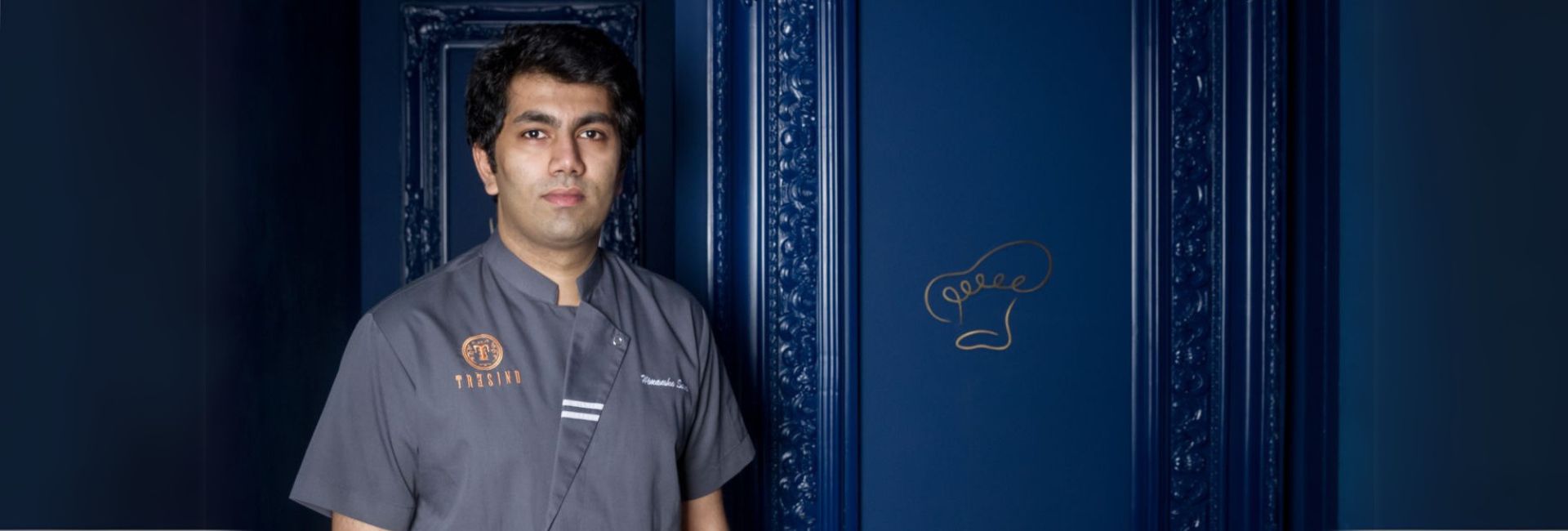(May 25, 2025) In a quiet moment on stage in Dubai, Chef Himanshu Saini stood still, taking it all in. The applause had just begun after Trèsind Studio, his 20-seat restaurant, was named the first Indian restaurant ever to earn a third Michelin star. Wearing his chef’s whites and a look of disbelief, he paused before speaking. “This has not been a 100-foot journey but a marathon,” he said, adding, “I dedicate this award to my country and countrymen.”
For Chef Saini, the milestone was more than personal. It was a sign of how far Indian cuisine had come—and how much further it could go. Long seen as comfort food or takeaway fare, Indian food is now part of the fine-dining conversation, thanks to chefs like him. Through dishes that reimagine chaat as a canapé or turn curd rice into a course on a tasting menu, Saini has helped reshape global perceptions of Indian cuisine: bold but refined, rooted yet progressive.

Tresind wins third Michelin star
From Home Cooking to High Tables
Long before Michelin stars and international accolades, Chef Himanshu’s love affair with cooking began in the bylanes of Old Delhi. He grew up in Sui Walan, a busy neighbourhood in Old Delhi known for its crowded markets and street food stalls. In his maternal grandparents’ home, a joint family of nearly fifty relatives, the kitchen was the heart of daily life. “We used to live together with our extended family of about 50 people, for whom we had to prepare three meals a day. My grandmother would assign tasks in the kitchen to everyone in the house, similar to the way we work in a professional kitchen,” Saini recalls. As a young boy,he would help his mother in the kitchen—peeling vegetables, stirring pots, and taking in the smells and sounds of the busy household kitchen. “I always spent my time with her in the kitchen and gave her a helping hand,” he explains.
Those early days sparked his interest in food, and he later decided to turn that passion into a profession. He studied at the Institute of Hotel Management in Aurangabad, where he received formal training in culinary arts and hospitality. His first break came at Indian Accent, a well-known restaurant in Delhi that helped shape modern Indian fine dining. There, Himanshu worked under the mentorship of celebrated chef Manish Mehrotra, an experience that would fundamentally shape his approach. “What I learned at Indian Accent formed the basis of what I’m doing right now,” Saini affirms. “My chef at Indian Accent, Manish Mehrotra, is the one to whom I always look up and who probably guided my career. From an early age, I was seeing things that were never done in the Indian kitchen”. Watching his mentor experiment with Indian flavours showed Himanshu that tradition and modern ideas could work together on the same plate. It was a lesson he carried with him as he developed his own style.
View this post on Instagram
Reimagining Indian Food for a New Era
With a mix of creativity and formal training, Himanshu Saini became part of India’s growing modern food scene. He worked as the opening chef for restaurants like Masala Library and Farzi Café, both known for giving Indian dishes a fresh, contemporary twist. These roles helped him learn how to mix new ideas with traditional flavours.
Saini believes that modern Indian food shouldn’t lose its roots. “The term ‘modern’ can be confusing,” he once said. “There are so many ways to modernise Indian food, but sometimes the true essence gets lost.” For him, it’s not about adding gimmicks or forgetting tradition—it’s about letting the cuisine grow and evolve. “My idea of modern cuisine is more about evolution,” he explained, noting that Indian food has always changed over time, taking in new ingredients like tomatoes and potatoes as history unfolded.
His ability to look at Indian food in a new way quickly became his strength. By his mid-twenties, he was seen as one of India’s most promising young chefs. He wasn’t afraid to serve street-style chaat on fine plates or mix traditional Indian curries with surprising ingredients. This creative approach prepared him for the next big step in his journey—one that would take him beyond India.
View this post on Instagram
A Bold Move to Dubai
In the early 2010s, Himanshu was thinking about his next move. He had two options: go to New York or take a chance on Dubai’s growing food scene. He first went to New York — what he jokingly calls “my route to Dubai via New York” — but soon realised that Dubai offered more opportunities. The city was expanding quickly, full of international visitors, and eager for new food experiences. In 2014, he moved to Dubai to lead a modern Indian restaurant called Trèsind. It turned out to be a key moment in his career. “In this city, I’ve been able to show the world what Indian food can be,” he later said. “Dubai is a place where people from all over the world pass through, and it welcomes everyone with open arms.”
Saini soon realised that Dubai was the perfect place to bring his food ideas to life. The city’s mix of cultures and love for fine dining gave him the freedom to experiment. At Trèsind — short for “very Indian”— he impressed diners with creative tasting menus that blended familiar Indian flavours with modern techniques.
He served dishes like a deconstructed pani puri that popped with tamarind water, and a stylish chaat tart topped with yogurt and chutney foam. These playful yet thoughtful plates showed that Indian food could be just as modern and artistic as any other global cuisine. Both guests and critics were drawn to his ability to innovate while still honouring the roots of Indian cooking.
Trèsind Studio: Innovation with Indian Soul
In 2018, Saini opened Trèsind Studio—a 20-seat space designed for creative exploration. It started as a hidden spot behind an unmarked door and is now located on Dubai’s Palm Jumeirah. The Studio offers a seasonal tasting menu that blends storytelling, emotion, and bold reinterpretations of Indian dishes.

Saini compares the concept to a butterfly—a symbol of change—showing how each course transforms Indian cuisine while keeping its essence. A dish might turn a Maharashtrian comfort food into a canapé, or rework South Indian curd rice as a delicate global-style congee.
“My agenda is to make people understand what Indian food is. It’s a very underrated cuisine that has great potential,” Saini says of his mission. “I’m trying to simplify a complex cuisine booming with diversity, while telling stories that have never been told before… I want to challenge common perceptions of Indian food by showcasing flavors, both new and familiar, in an unconventional way.”
Every dish at Studio tells a story—about India’s regions, its food traditions, or Saini’s own memories—served in creative, unexpected ways.
This fresh approach earned Trèsind Studio critical acclaim. It received its first Michelin star in 2022, followed by a second in 2023. At that time, Saini was the only Indian-born chef to lead a two-Michelin-star Indian restaurant. Trèsind Studio also earned a place in the World’s 50 Best Restaurants for the Middle East and climbed up global rankings. Yet through all the recognition, Saini continued to push boundaries, driven by one goal: to take Indian cuisine to new heights.
Indian Cuisine on the Global Map
In May 2025, Trèsind Studio made history by becoming the first Indian restaurant to earn a third Michelin star — Michelin’s highest honour, given only to restaurants truly worth travelling for.
View this post on Instagram
For Saini, it was a powerful moment of validation. “We are deeply humbled to receive this extraordinary recognition. To be awarded three Michelin stars is a testament to our team’s unrelenting passion and belief in the power of storytelling through food,” he said.
His goal, he added, has always been to present Indian cuisine “not just as nostalgic but as progressive and worthy of the world’s highest culinary accolades”—a vision now fully realised.
From the crowded streets of Old Delhi to one of the world’s most respected kitchens, Himanshu Saini has quietly changed the way people see Indian food. His cooking doesn’t try to impress with loud ideas—it asks people to slow down, taste carefully, and see Indian cuisine in a new light. For years, Indian food has often been reduced to a few familiar dishes. Saini is bringing back its richness, variety, and heart. The third Michelin star is just a symbol. What matters more is that people are finally listening to the stories he tells—one plate at a time.
- Follow Chef Himashu Saini on Instagram
ALSO READ | Chef Garima Arora on second Michelin star win: It belongs to my team




